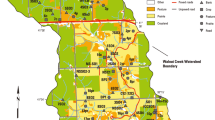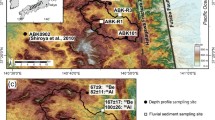Abstract
Because ombrotrophic peat bogs receive inputs of water, nutrients, pollutants, and xerobiotic materials solely from the atmosphere, and accumulate organic matter vertically, dated peat cores can provide a historical record of deposition. We propose a novel method for accurately determining dates of peat, based on cosmogenic 10Be. In a laboratory study, we document limited post-depositional mobility of atmospherically-deposited Be, a requisite for 10Be dating. We provide an example of how the 210Pb-dated upper portion of a peat core can be used to back-calculate a site-specific 10Be deposition rate, which can then be used to estimate dates for peat throughout a core, and also discuss limitations to the application of cosmogenic 10Be to the dating of peat deposits.



Similar content being viewed by others
References
Appleby PG, Oldfield FR (1978) The calculation of 210Pb dates assuming a constant rate of supply of unsupported 210Pb to the sediment. Catena (Suppl) 5:1–8
Beer J (2000) Long-term indirect indices of solar variability. Space Sci Rev 94:53–66
Clymo RS (1984) The limits to peat bog growth. Philos Trans R Soc Lond B 303:605–645
Clymo RS, Oldfield F, Appleby PG, Pearson GW, Ratnessar P, Richardson N (1990) A record of atmospheric deposition in a rain-dependent peatland. Philos Trans R Soc Lond, Ser B 327:331–338
Egli M, Brandová D, Böhlert R, Favilli F, Kubik PW (2010) 10Be inventories in Alpine soils and their potential for dating land surfaces. Geomorphology. doi:10.1016/j.geomorph.2010.02.019
EPA (1999) Standard operating procedure for the digestion of aqueous and solid samples using the Standard Contract Laboratory Program (CLP) hotplate/beaker digestion technique, Metals 033. US Environmental Protection Agency, Region 5 Central Regional Laboratory, Chicago
Field CV, Schmidt GA, Koch D, Salyk C (2006) Modeling production and climate-related impacts on 10Be concentration in ice cores. J Geophys Res 111:D15107. doi:10.1029/2005JD006410
Heikkilä U, Beer J, Feichter J (2008) Modeling cosmogenic radionuclides 10Be and 7Be during the Maunder minimum using the ECHAM5-HAM General Circulation Model. Atmos Chem Phys 8:2797–2809
Korschinek G, Bergmaier A, Faestermann T, Gerstmann UC, Knie K, Rugel G, Wallner A, Dillman I, Dollinger G, Lierse von Gostomski Ch, Kossert K, Maiti M, Poutivsev M, Remmert A (2010) A new value for the half-life of 10Be by heavy ion elastic recoil detection and liquid scintillation counting. Nucl Instrum Methods Phys Res B268:187–191
Lal D, Peters B (1967) Cosmic ray produced radioactivity on earth. In: Flügge S (ed) Handbuch für physik. Springer, New York, pp 551–612
McHargue LR, Damon PE (1991) The global beryllium-10 cycle. Rev Geophys 29:141–158
Raisbeck GM, Yiou F, Fruneau M, Loiseaux JM, Lieuvin M, Ravel JC (1981) Cosmogenic 10Be/7Be as a probe of atmospheric transport processes. Geophys Res Lett 8:1015–1018
Sharma P, Bourgeois M, Elmore D, Granger D, Lipschutz ME, Ma X, Miller T, Mueller K, Rickey F, Simms P, Vogt S (2000) PRIME lab AMS performance, upgrades, and research publications. Nucl Instrum Methods Phys Res B 172:112–123
Turetsky MR, Manning S, Wieder RK (2004) Dating of recent peat deposits: review of current methodology and a case study in wiggle-matching. Wetlands 24:324–356
Turetsky MR, Wieder RK, Vitt DH, Evans R, Scott KD (2007) The disappearance of relict permafrost in boreal regions: effects on peatland carbon storage and fluxes. Glob Change Biol 13:1–13
Vile MA, Wieder RK, Novák M (1999) Mobility of Pb in Sphagnum-derived peat. Biogeochemistry 45:35–52
Vonmoos M, Beer J, Muscheler R (2006) Large variations in Holocene solar activity: constraints from 10Be in the Greenland Ice Core Project ice core. J Geophys Res 111:A10105. doi:10.1029/2005JA011500
Wieder RK, Turetsky M, Vile MA (2009) Wetlands as archives of past atmospheric, climatic and environmental conditions. In: Maltby E, Barker T (eds) The wetlands handbook. Blackwell Publishing Ltd, Oxford, pp 96–112
Willenbring JK, von Blanckenburg F (2010) Meteoric cosmogenic 10Be adsorbed to river sediment and soil: applications for Earth-surface dynamics. Earth Sci Rev 98:105–122
Acknowledgments
This research was supported by National Science Foundation grant DEB-9985855 and by a Purdue University PRIME Laboratory Seed Grant (for a portion of the 10Be analyses).
Author information
Authors and Affiliations
Corresponding author
Rights and permissions
About this article
Cite this article
Wieder, R.K., Vile, M.A. & Scott, K.D. Cosmogenic 10Be as a potential dating tool in peat. Biogeochemistry 101, 177–182 (2010). https://doi.org/10.1007/s10533-010-9468-8
Received:
Accepted:
Published:
Issue Date:
DOI: https://doi.org/10.1007/s10533-010-9468-8




